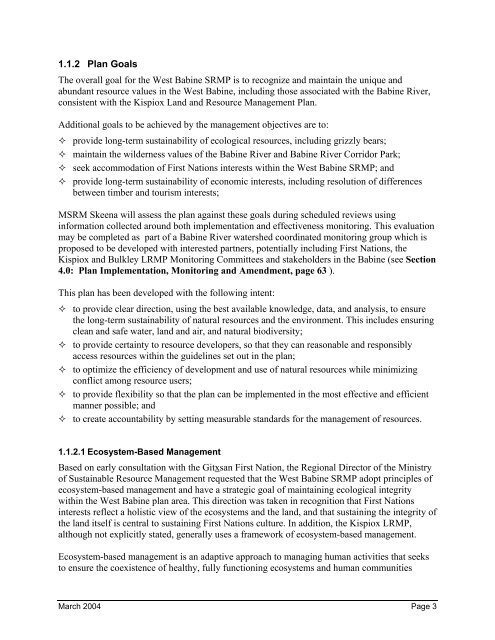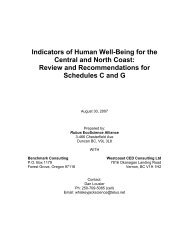West Babine Sustainable Resource Management Plan
West Babine Sustainable Resource Management Plan
West Babine Sustainable Resource Management Plan
You also want an ePaper? Increase the reach of your titles
YUMPU automatically turns print PDFs into web optimized ePapers that Google loves.
1.1.2 <strong>Plan</strong> Goals<br />
The overall goal for the <strong>West</strong> <strong>Babine</strong> SRMP is to recognize and maintain the unique and<br />
abundant resource values in the <strong>West</strong> <strong>Babine</strong>, including those associated with the <strong>Babine</strong> River,<br />
consistent with the Kispiox Land and <strong>Resource</strong> <strong>Management</strong> <strong>Plan</strong>.<br />
Additional goals to be achieved by the management objectives are to:<br />
provide long-term sustainability of ecological resources, including grizzly bears;<br />
maintain the wilderness values of the <strong>Babine</strong> River and <strong>Babine</strong> River Corridor Park;<br />
seek accommodation of First Nations interests within the <strong>West</strong> <strong>Babine</strong> SRMP; and<br />
provide long-term sustainability of economic interests, including resolution of differences<br />
between timber and tourism interests;<br />
MSRM Skeena will assess the plan against these goals during scheduled reviews using<br />
information collected around both implementation and effectiveness monitoring. This evaluation<br />
may be completed as part of a <strong>Babine</strong> River watershed coordinated monitoring group which is<br />
proposed to be developed with interested partners, potentially including First Nations, the<br />
Kispiox and Bulkley LRMP Monitoring Committees and stakeholders in the <strong>Babine</strong> (see Section<br />
4.0: <strong>Plan</strong> Implementation, Monitoring and Amendment, page 63 ).<br />
This plan has been developed with the following intent:<br />
to provide clear direction, using the best available knowledge, data, and analysis, to ensure<br />
the long-term sustainability of natural resources and the environment. This includes ensuring<br />
clean and safe water, land and air, and natural biodiversity;<br />
to provide certainty to resource developers, so that they can reasonable and responsibly<br />
access resources within the guidelines set out in the plan;<br />
to optimize the efficiency of development and use of natural resources while minimizing<br />
conflict among resource users;<br />
to provide flexibility so that the plan can be implemented in the most effective and efficient<br />
manner possible; and<br />
to create accountability by setting measurable standards for the management of resources.<br />
1.1.2.1 Ecosystem-Based <strong>Management</strong><br />
Based on early consultation with the Gitxsan First Nation, the Regional Director of the Ministry<br />
of <strong>Sustainable</strong> <strong>Resource</strong> <strong>Management</strong> requested that the <strong>West</strong> <strong>Babine</strong> SRMP adopt principles of<br />
ecosystem-based management and have a strategic goal of maintaining ecological integrity<br />
within the <strong>West</strong> <strong>Babine</strong> plan area. This direction was taken in recognition that First Nations<br />
interests reflect a holistic view of the ecosystems and the land, and that sustaining the integrity of<br />
the land itself is central to sustaining First Nations culture. In addition, the Kispiox LRMP,<br />
although not explicitly stated, generally uses a framework of ecosystem-based management.<br />
Ecosystem-based management is an adaptive approach to managing human activities that seeks<br />
to ensure the coexistence of healthy, fully functioning ecosystems and human communities<br />
March 2004 Page 3

















